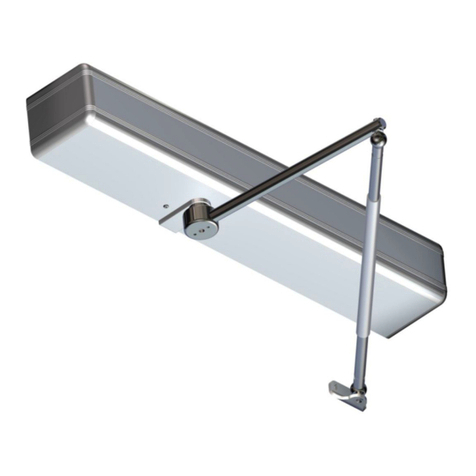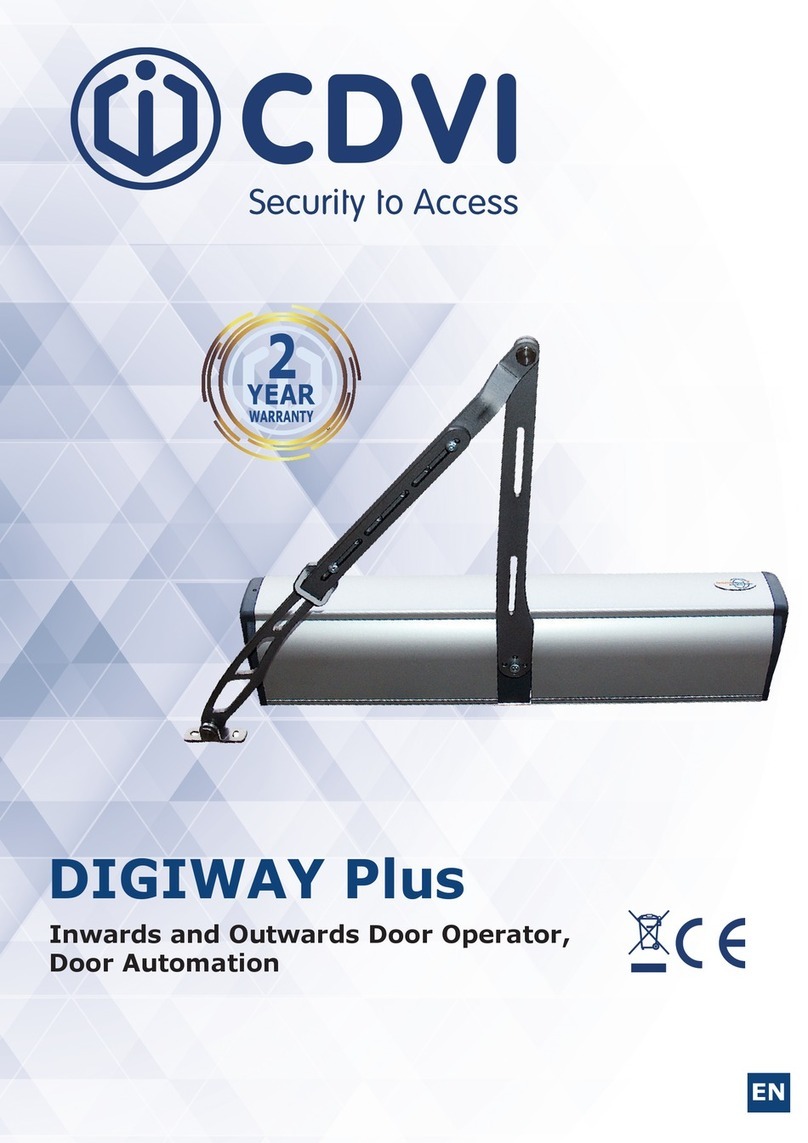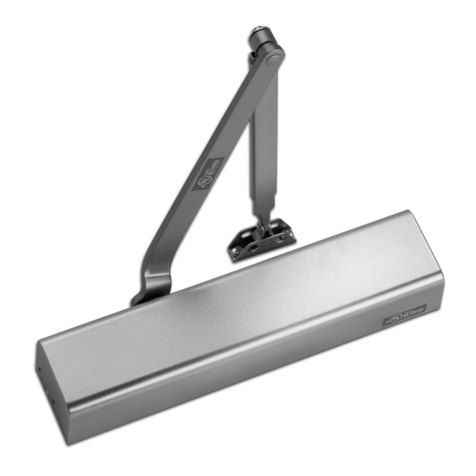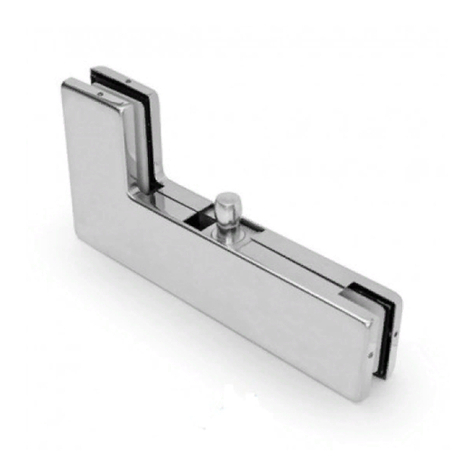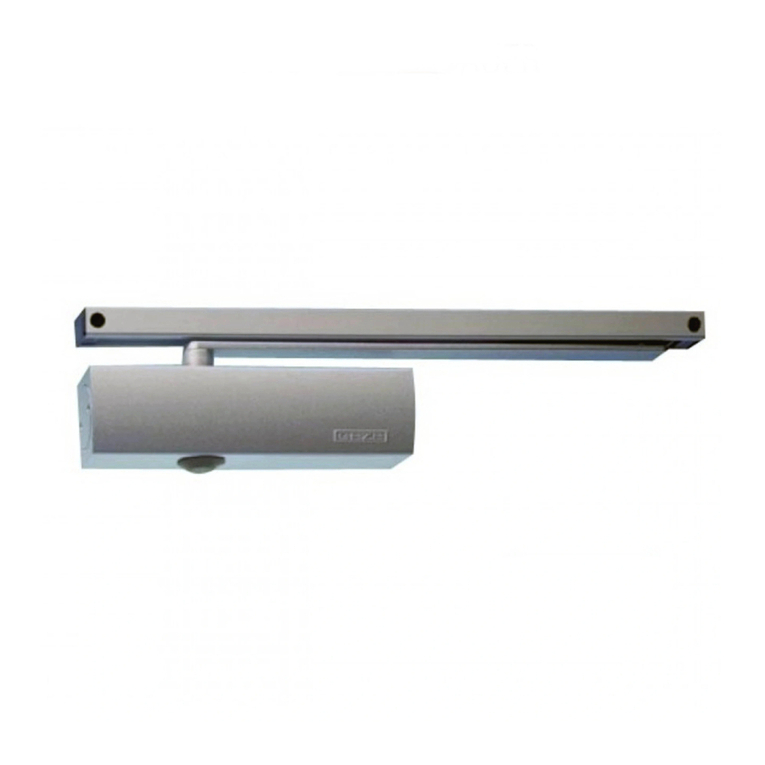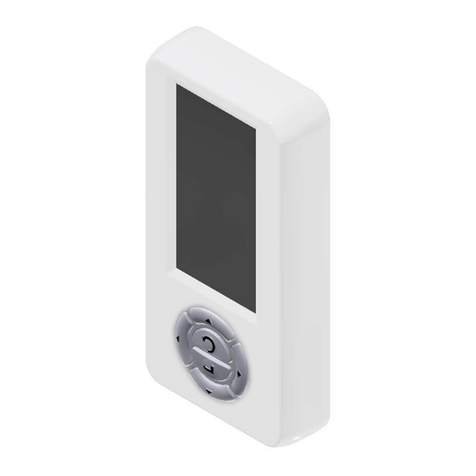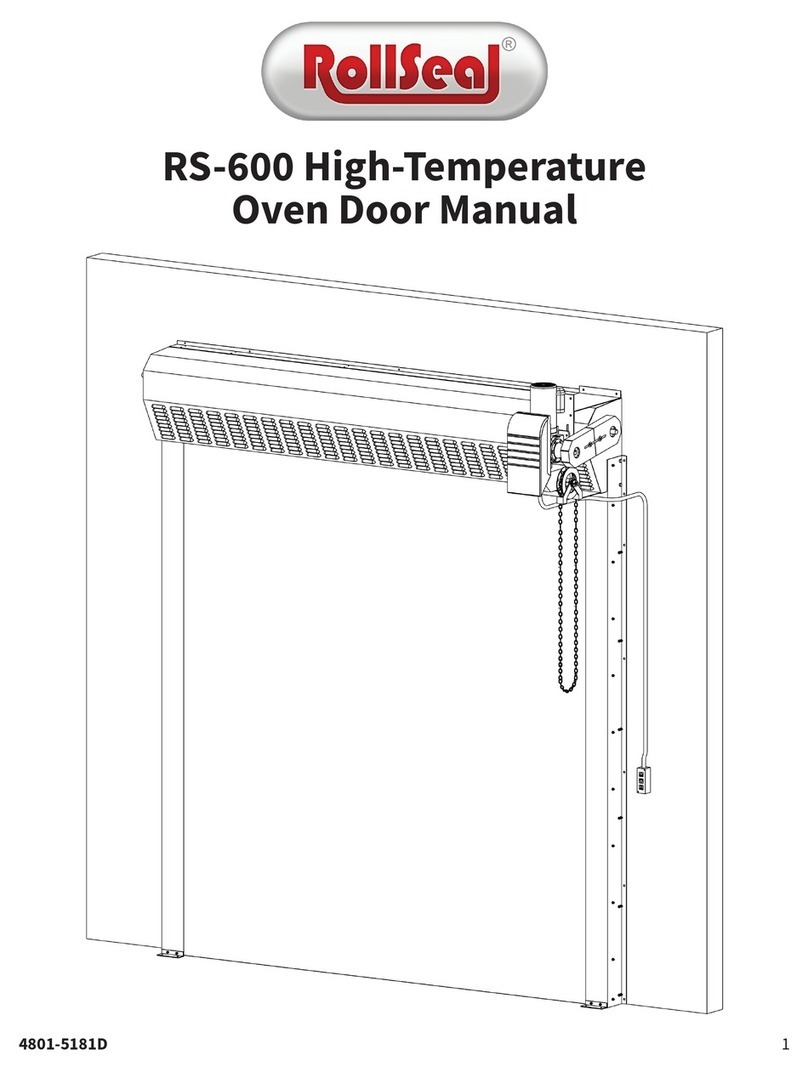Smartdoor TURN T100 User manual

301057 2021-03-26
Operating Instructions
Swing Door Operator
smartdoor TURN T100
Language: English

smartdoor TURN T100 | Operating Instructions
2
Table of contents
1GENERAL INFORMATION......................................................................................... 5
1.1 PRODUCT IDENTIFICATION ................................................................................... 5
1.2 PRODUCT OVERVIEW............................................................................................ 6
1.2.1 THE BASIC MODULE ............................................................................................. 6
1.2.2 THE LINKAGE..................................................................................................... 7
1.2.3 THE OPERATING ELEMENTS..................................................................................... 7
1.2.4 THE SAFETY ELEMENTS ......................................................................................... 7
1.2.5 THE DRIVE MODULE ............................................................................................. 7
1.2.6 THE CONTROL MODULE ......................................................................................... 8
1.2.7 THE COMMUNICATION MODULE ................................................................................ 8
1.2.8 THE SMARTDOOR SERVICE TOOL.............................................................................. 9
1.2.9 THE SMARTDOOR APP .......................................................................................... 9
2SAFETY ................................................................................................................. 10
2.1 SYMBOLS AND DISPLAY OF WARNINGS ................................................................ 10
2.2 STATE-OF-THE-ART AND APPLIED STANDARDS...................................................... 10
2.3 INTENDED USE .................................................................................................. 13
2.4 LIMITATION OF LIABILITY ................................................................................... 13
2.5 USER GROUP ..................................................................................................... 13
2.6 RISK................................................................................................................. 13
2.7 MISUSE............................................................................................................. 13
3PRODUCT DESCRIPTION ....................................................................................... 15
3.1 TERMS .............................................................................................................. 15
3.2 SWING DOOR TERMS.......................................................................................... 16
3.3 LINKAGE TYPES ................................................................................................. 17
3.4 HOLDING VARIANTS ........................................................................................... 20
3.4.1 DOOR HANDLE WITH LATCH (WITH AND WITHOUT LOCK) ................................................ 20
3.4.2 DOOR HANDLE WITH BLOCKED LATCH (WITH AND WITHOUT LOCK)..................................... 20
3.4.3 DOOR HANDLE WITH LATCH AND ELECTRIC DOOR OPENER ............................................... 21
4ASSEMBLY............................................................................................................. 22
4.1 SAFETY DURING ASSEMBLY: ............................................................................... 22
4.2 MECHANICAL INSTALLATION ............................................................................... 22
4.2.1 MOUNTING PLATE ............................................................................................. 23
4.2.2 ADAPTER PLATE................................................................................................ 24
4.2.3 ASSEMBLY LINKAGE ........................................................................................... 24
4.2.4 LINKAGE DISASSEMBLY ....................................................................................... 25
4.3 ELECTRIC INSTALLATION .................................................................................... 26
4.3.1 CONNECTION .................................................................................................. 26
4.4 COMMISSIONING VIA AUTO-LEARNING FUNCTION................................................. 26
4.4.1 FUNCTIONAL TEST (COMMISSIONING PUSH&GO)......................................................... 27
4.4.2 FUNCTIONAL TEST (AFTER INSTALLATION)................................................................. 27
4.4.3 HOLDING FORCE FUNCTIONAL TEST IN THE CASE OF CURRENT INTERRUPTION ........................ 27
4.4.4 FUNCTION TEST (START AFTER CURRENT INTERRUPTION)................................................ 27
4.5 COMMISSIONING OPERATING ELEMENTS.............................................................. 28
4.5.1 BLUETOOTH OPERATING ELEMENTS ......................................................................... 28
4.5.1.1 ADDITION OF BLUETOOTH OPERATING ELEMENTS ...................................................... 28
4.5.1.2 DELETING BLUETOOTH OPERATING ELEMENTS .......................................................... 29
4.5.1.3 COMMISSIONING OF SMARTDOOR BLUETOOTH PUSH BUTTON ........................................ 29
4.5.1.4 COMMISSIONING OF SMARTDOOR BLUETOOTH MODULE (WITH PUSH BUTTON) .................... 30
4.5.1.5 ADDITION OF SMARTPHONE ............................................................................... 31
4.5.2 WIRED OPERATING ELEMENTS ............................................................................... 31

smartdoor TURN T100 | Operating Instructions
3
4.5.2.1 CONNECTION OF EXTERNAL CONTACTS .................................................................. 31
4.5.2.2 WIRED OPENING PULSES .................................................................................. 31
4.5.2.3 COMMISSIONING WIRED PUSH BUTTON.................................................................. 31
4.5.2.4 COMMISSIONING WIRED RADAR .......................................................................... 32
4.6 COMMISSIONING SAFETY ELEMENTS.................................................................... 32
4.6.1 COMMISSIONING SIO AND SIS PRESENCE SENSORS .................................................... 33
4.6.1.1 CONNECTION SIO /SIS.................................................................................. 33
4.6.1.2 TEST SIGNAL TEST ........................................................................................ 33
4.6.2 COMMISSIONING ELECTRIC DOOR OPENER (COM, NO AND NC)....................................... 34
4.6.3 COMMISSIONING MOTOR LOCK (COM, NO AND NC AND MORE)....................................... 35
4.6.4 COMMISSIONING DAY/NIGHT SWITCH-OVER.............................................................. 36
5FUNCTIONS........................................................................................................... 37
5.1 AUTOMATIC SWITCH-ON FUNCTION AFTER POWER FAILURE ................................... 37
5.2 AUTOMATIC TROUBLESHOOTING FUNCTION.......................................................... 37
5.3 AUTO-LEARNING FUNCTION ................................................................................ 38
5.3.1 PREREQUISITES ............................................................................................... 38
5.3.2 IMPLEMENTATION OF THE AUTO-LEARNING FUNCTION (WITH PROG KEY) ............................ 39
5.4 LOW-ENERGY MODE ........................................................................................... 40
5.5 FUNCTIONS OF INPUTS AND OUTPUTS ................................................................. 41
5.5.1 SIO: SAFETY SENSOR OPENING ............................................................................ 41
5.5.2 SIS: SAFETY SENSOR CLOSING............................................................................. 41
5.5.3 OPENING PULSE (DAY+NIGHT) ............................................................................. 41
5.5.4 OPENING PULSE (DAY+NIGHT)+LOCK FEEDBACK ...................................................... 41
5.5.5 OPENING PULSE (DAY) ....................................................................................... 41
5.5.6 DAY/NIGHT SWITCH-OVER................................................................................... 42
5.5.7 LOCK FEEDBACK ............................................................................................... 42
5.5.8 MODE SWITCH-OVER ........................................................................................ 42
6OPERATING MODE ................................................................................................ 43
6.1 AUTOMATIC OPERATING MODE (LED: GREEN) ....................................................... 43
6.2 OPERATING MODE - CONTINUOUSLY OPEN (LED: FLASHING GREEN) ....................... 44
6.3 OPERATING STATUS INITIALISATION (LED: FLASHING ORANGE)............................. 44
6.4 AUTO-LEARNING OPERATING STATUS (LED: FLASHING RED/ORANGE)..................... 45
6.5 SYSTEM ERROR OPERATING STATUS (LED: FLASHING RED).................................... 45
7OPERATION .......................................................................................................... 46
7.1 MAIN SWITCH.................................................................................................... 46
7.2 SETTING THE HOLD-OPEN TIME ........................................................................... 46
7.2.1 PROCESS ....................................................................................................... 46
7.3 MANUAL RESET OF AN ERROR ............................................................................. 47
7.3.1 PROCESS ....................................................................................................... 47
7.4 SWITCHING OVER THE OPERATING MODE............................................................. 47
7.4.1 SWITCH-OVER OF THE OPERATING MODE .................................................................. 47
7.5 SMARTDOOR APP ............................................................................................... 48
7.5.1 SYMBOLS ....................................................................................................... 48
7.5.2 MAIN MENU -MY DOORS..................................................................................... 49
7.5.3 CONNECT NEW DOOR OPERATOR IN THE APP.............................................................. 49
7.5.4 PASSWORD FOR RELEASE OF A SMARTPHONE .............................................................. 49
7.5.5 DOOR CONTROL ............................................................................................... 50
7.5.6 USER MANUAL /FAQ ......................................................................................... 51
8SERVICE................................................................................................................ 52
8.1 CARE / OPERATOR CHECKS ................................................................................. 52
8.1.1 SWITCH OFF ................................................................................................... 52
8.1.2 CHECKS ........................................................................................................ 52
8.1.3 CARE............................................................................................................ 52
8.2 MAINTENANCE / INSPECTION BY TRAINED SPECIALIST PERSONNEL ........................ 52

smartdoor TURN T100 | Operating Instructions
4
9TROUBLESHOOTING.............................................................................................. 53
9.1 RESET............................................................................................................... 53
9.1.1 PROCESS ....................................................................................................... 53
10 TECHNICAL DATA ............................................................................................... 54
10.1 AREA OF USE AND OPENING TIMES IN LOW-ENERGY OPERATION ............................ 54
11 APPENDIX .......................................................................................................... 55
11.1 CONNECTING TERMINALS ................................................................................... 55
11.2 ASSIGNMENT OF FUNCTION TO INPUTS AND OUTPUTS .......................................... 56
11.3 DISPLAY LED AND SYSTEM ERROR ....................................................................... 57
11.3.1 COMMUNICATION MODULE ................................................................................... 57
11.3.2 CONTROL MODULE ............................................................................................ 57
11.4 CONSTRUCTION PLANNER TEMPLATE –OBJECT OVERVIEW..................................... 59
11.5 CONSTRUCTION PLANNER TEMPLATE –ELECTRICAL DIAGRAM ................................ 60
11.6 ELECTRICAL DIAGRAMS ...................................................................................... 61
11.6.1 EXAMPLE ELECTRIC DOOR OPENER (MASTER).............................................................. 61
11.6.2 EXAMPLE ELECTRIC DOOR OPENER (MASTER WITH RELEASE)V1 ........................................ 62
11.6.3 EXAMPLE ELECTRIC DOOR OPENER (MASTER WITH RELEASE)V2 ........................................ 63
11.6.4 EXAMPLE ELECTRIC DOOR OPENER (SLAVE)................................................................ 64
11.6.5 EXAMPLE CONVERSION OF ELECTRIC DOOR OPENER WITH INTERCOM SYSTEM (DC) ................. 65
11.6.6 EXAMPLE MOTOR LOCK (MASTER-MASTER)................................................................. 66
11.6.7 EXAMPLE MOTOR LOCK (MASTER-SLAVE)................................................................... 67
11.7 PUSH BUTTON TEMPLATE .................................................................................... 68
11.8 AUTO-LEARNING FUNCTION ................................................................................ 69

smartdoor TURN T100 | Operating Instructions
5
1General information
1.1 Product identification
For precise identification the type plate attached to the control module is marked with the
following details:
Company name: Gotthard 3 Mechatronic Solutions AG
Gotthardstrasse 3
CH –5630 Muri (AG)
Type: smartdoor TURN T100
Serial number: e.g. 0100-01-01-01-20-0000-0535
Reference number: 301010a
Year of manufacture: e.g. 2020
Mains connection: e.g. 100-240 V, 50/60 Hz
Power consumption: 41 W
Rated load: 30 Nm
Admissible temperature range: -15 °C to +50 °C
Classified according to DIN 18650-1:
Installation firm: (place holder for installation firm sticker)
Photographic example:
Figure 1: Product identification
1
2
3
4
5
6
7
8
1
2
1
2.3
0
2

smartdoor TURN T100 | Operating Instructions
6
1.2 Product overview
Figure 2: Product overview
1.2.1 The basic module
The new EN 16005 standard defines the LOW-ENERGY operating mode and allows a door
operator to operate without safety elements without danger of injury. The smartdoor TURN
targets precisely this application. With its Auto-Learning function it automatically calculates the
necessary door parameters and makes easy work of commissioning. No safety elements are
required.
Figure 3: smartdoor TURN T100 basic module

smartdoor TURN T100 | Operating Instructions
7
1.2.2 The linkage
The smartdoor TURN can be fitted with the following linkage types:
•Sliding linkage
•Scissor linkage
The linkage types and their uses are described in chapter 3.3 Linkage types.
1.2.3 The operating elements
The smartdoor TURN can be fitted with the following elements:
•smartdoor Bluetooth button which opens the smartdoor TURN and can switch between the
operating modes
•Standard switch, which opens the smartdoor TURN or can switch between the operating
modes with the smartdoor Bluetooth module
•smartdoor APP which can open the smartdoor TURN, switch between the operating modes
and change parameters
•Wired standard switch which can open the smartdoor TURN
•Wired radar which can open the smartdoor TURN
A separate function can be assigned to each button e.g. as opening contact (Day + Night),
opening contact (Day), or mode switch
Figure 4: Operating element examples
If there is an additional switch for disabled persons to activate the drive, a pictogram needs to
be applied to the button in accordance with EN 16005 Appendix D - picture D.1.
1.2.4 The safety elements
If you want to connect safety elements then the smartdoor TURN offers as standard a
connection strip for all standard safety elements.
The smartdoor TURN can be fitted with the following safety elements:
•Presence sensors which control the swing range of the door in the opening direction (SIO)
•Presence sensors which control the swing range of the door in the closing direction (SIS)
•All standard motor locks and electric door openers (working current, static current)
•Key switches, rotary switches or timers, to switch between day and night mode
Figure 5: Examples of safety elements
1.2.5 The drive module
This 1.7 kg, extremely compact power pack can supply a drive-side torque of over 30 Nm and is
practically silent. So that a driven door can also be actuated easily by hand (even without
electricity), its internal efficiency on both sides has been corresponding optimised. The sensor
system, integrated into the gearbox, allows a rapid and optimum reaction of the control system
to external influences. (detection of obstacles, wind pressure etc.)

smartdoor TURN T100 | Operating Instructions
8
Figure 6: Drive module
In the +/-15° range a mechanical reset torque is generated internally such that the door can be
held in the closed position without motor power. Thus, in the currentless state the door behaves
like a self-closing drawer.
The closing torque is symmetrically present in both directions of rotation. For this reason, a
swing door is held mechanically in the middle position, even in the currentless state.
1.2.6 The control module
The control module incorporates the control system, the connecting terminals and the power
supply.
Figure 7: Control module
The control module automatically learns (Auto-Learning) the correct direction of rotation and the
closing characteristic and saves this with system-related standard and limit values.
All possible connection options and the entire kinematic (lever systems, mass of the door leaf,
limit positions etc.) are detected and tested by the control module before each door opening.
1.2.7 The communication module
The smartdoor TURN has a communication module, which permits a switch-over of the
operating mode and communication with other devices. The communication module allows rapid
switching from Automatic mode to Continuously Open and back. An existing error can also be
manually acknowledged and the hold-open time set.
Figure 8: Communication module
More operating modes can be activated as required with the Service Tool.
The communication module is responsible for the communication with the smartdoor Bluetooth
button, Bluetooth modules, smartdoor APP and the Service Tool.

smartdoor TURN T100 | Operating Instructions
9
1.2.8 The smartdoor Service Tool
The smartdoor Service Tool can be used by the service technician on a Windows Notebook to
carry out a wide range of adjustments after mechanical installation. This includes the following:
•Setting the parameters
•Activation of Bluetooth devices
•Saving and loading of parameter recipes
•Auto-Learning
•Managing and loading firmware
•Status overview for controlled commissioning of external equipment
The Service Tool is only for trained specialist personnel. A detailed description of the smartdoor
Service Tool is provided in a separate handbook.
Figure 9: smartdoor Service Tool
1.2.9 The smartdoor APP
The smartdoor TURN can be operated and adjusted using the smartdoor APP.
A detailed description of the smartdoor APP can be found in chapter 7.5 smartdoor APP .
Figure 10:smartdoor APP

smartdoor TURN T100 | Operating Instructions
10
2Safety
2.1 Symbols and display of warnings
Various symbols are used in these operating instructions for easier understanding:
NOTICE
Tips and information, which help you work correctly and efficiently.
CAUTION
Important note, when materials are damaged or the function can be affected.
WARNING
Important note, when materials are damaged or the function can be affected.
2.2 State-of-the-art and applied standards
The system complies with the state-of-the-art and accredited safety technology rules. It has
been developed, constructed and produced in compliance with the following standards:
•Machinery Directive 2006/42/EC
•Household and similar electrical appliances. Safety. EN 60335-1
•Particular requirements for drives for gates, doors and windows EN 60335-2-103 (where
applicable)
•Power operated pedestrian doorsets. Safety in use. Requirements and test methods. EN
16005.
•Safety-related parts of control systems EN ISO 13849
13849-1:2016 (General design principles), category 2 PL c
13849-2:2016 (Validation)
•Electromagnetic compatibility (EMC) EN61000
Part 6-2: Generic standards –Immunity for industrial environments
Part 6-3: Generic standards –Emission standard for residential, commercial and light-
industrial environments
NOTICE
Partly completed machinery in the sense of the EC directive 2006/42/EC is only
designed to be installed in or combined with other machinery or in other partly
completed machinery or systems to form a machine in the sense of the above
directive.

smartdoor TURN T100 | Operating Instructions
11
WARNING
This product may not be operated until it has been determined that the whole
machine / system in which it has been installed, corresponds to the provisions of the
above EC directive.
In the event of any alteration of the product without the manufacturer's approval,
this declaration loses its validity.
NOTICE
The installer and operator must jointly carry out a risk assessment during the
planning of the system.

smartdoor TURN T100 | Operating Instructions
12
Encoding systems for automatic doors (DIN 18650)
1 –swing door operator
2 –Sliding door operator
3 –Swing/sliding door operator
4 –Folding door operator
5 –Revolving door drive
Drive type
1
1 –200,000 test cycles at min. 1200 cycles/24 h
2 –500,000 test cycles at min. 2400 cycles/24 h
3 –1,000,000 test cycles at min. 4000 cycles/24 h
Durability of the drive
2
1 –Swing door
2 –Sliding door
3 –Swing/sliding door
4 –Folding door
5 –Revolving door
Door leaf type
3
0 –Not suitable as fire door
1 –Suitable as smoke-protection door
2 –Suitable as fire door
3 –Suitable as fire door & smoke-protection door
Suitability as fire door
4
1 –Force limit
2 –Connection for external safety systems
3 –Low energy
Safety devices on the drive
5
0 –No particular requirements
1 –In escape routes with a break-out fitting
2 –In escape routes without a break-out fitting
3 –For self-closing fire doors with break-out fitting
4 –For self-closing fire doors without a break-out
fitting
Special requirements of
drive/functions and
installation
6
0 –No safety devices
1 –With adequately dimensioned safety distances
2 –With protection against crushing, shearing and
trapping of fingers
3 –With built-in break-out fitting unit
4 –With presence sensor
Safety on the automatic
door system
7
1 –No specifications
2 –from -15 °C to +50 °C
3 –from -15 °C to +75 °C
4 –Temperature range in accordance with the
manufacturer's details
Ambient temperatures
8
Table 1: Encoding systems for automatic doors
Nos. 1, 2, 5, 6, 8 relate to the drives.
Nos. 3, 4, 7 relate to the complete door systems

smartdoor TURN T100 | Operating Instructions
13
2.3 Intended use
The smartdoor TURN T100 is an electromechanical swing door operator and is designed
exclusively for opening and closing swing doors for standard use in public and private dry
interiors and standard door heights.
Any other use is considered as improper use. The manufacturer is not liable for damage
resulting from improper use; the risk in this case lies entirely with the operator.
The smartdoor TURN T100 may not be used for escape routes.
Intended use of equipment also includes compliance with the manufacturer's operating
instructions and regular care and maintenance.
2.4 Limitation of liability
Manipulation or modification of the parameters of the automatic door, unless performed by an
authorised service technician, exempts the manufacturer from liability for any resulting damage.
Modifications of the parameters may only be carried out by qualified personnel.
Installation is at one's own risk and must take place in accordance with operating instructions.
The manufacturer accepts no responsibility for non-compliance.
Assembly, commissioning, inspection, maintenance and repair work on the system must be
conducted according to the check lists. The chapter on commissioning (See chapter 5.3 Auto-
Learning function) and the maintenance checklist (see inspection book) may be helpful here.
Children may not clean, play with or use the product.
2.5 User group
The swing door operator can be used by children from 8 years and above, elderly and frail users
and persons with disabilities or with lack of experience and knowledge when these are
supervised or have been instructed in relation to the safe use of the appliances and understand
the resulting dangers.
Otherwise, the swing door operator should only be used when the risk assessment for the user
indicates a low risk.
2.6 Risk
There are risks of shearing and crushing from the various closing edges and the linkage on
automatic doors. To avoid this danger there should be no items in the opening area of the swing
door. The securing of crushing and shearing points on secondary closing edges must be
guaranteed by the door manufacturer.
The danger point on the secondary closing edge on each swing door (including manually
operated) is generally recognised by all users of a door. It cannot be influenced by the
manufacturer.
2.7 Misuse
Foreseeable misuse is any use other than as described in these operating instructions. This
includes:
•mechanical or electrical bypassing
•The use of other than original parts
•Conversions, modifications and manipulations
•Non-compliance with the instructions
NOTICE
The manufacturer stated in this report is only the manufacturer of a drive and not
the manufacturer of the final machinery.

smartdoor TURN T100 | Operating Instructions
14
The operator is responsible for the operation of automatic door systems and for
regular maintenance and safety inspections.
The "Operator checks" checklist can be helpful for this (see inspection book).

smartdoor TURN T100 | Operating Instructions
15
3Product description
3.1 Terms
Term
Explanation
Hinge side
The side of the door on which the hinges are located, to which the
door leaf is attached. Usually, the side of the door facing the opening
direction.
Opposite hinge side
The other side of the door to the hinge side. Usually, the side of the
door facing the closing direction.
Contactor
Buttons, switches or motion detectors for actuation of the door
operator. Actuation function in "automatic" operating mode and
sometimes in other operating statuses.
Indoor opening
contact
(day + night)
Door opening button which is active in day and night mode and
which is usually mounted on the inside of the door.
The actuation function is activated in the "automatic" operating
mode and opens the door automatically at the press of a button.
Outdoor opening
contact
(day only)
Door opening button which is only active when day mode is actuated
and which is usually mounted on the outside of the door.
The actuation function is activated in the "automatic" operating
mode and opens the door automatically at the press of a button.
Push&Go
If the door is pushed manually out of the closed position in
"automatic" operating mode, the door opens automatically. The
sensitivity of this function can be set.
Safety sensor
Opening
(SIO)
Presence sensor (e.g., active infrared-light sensor or scanner) for
securing the door swing range in the opening direction. The sensor is
usually attached on the hinge side of the door to the door leaf and
triggers a STOP pulse.
Safety sensor Closing
(SIS)
Presence sensor (e.g. active infrared-light sensor or scanner) for
securing the door swing range in the closing direction. The sensor is
usually attached to the opposite hinge side of the door onto the door
leaf and triggers a REOPEN pulse.
Emergency stop
button
(EMERGENCY)
Self-latching emergency stop button, which can stop the door
operator immediately in an emergency. The EMERGENCY situation is
ended by releasing the emergency stop button.
Electric door opener
(LOCK)
Working and static current door opener (NC / NO) designed as AC or
DC door opener.
The delay time of the door opener is detected automatically by the
control system.
Lock feedback
(RR)
The lock feedback is an integrated contact in the door latch which is
actuated by the mechanical locking of the door with the door lock
bolt. It notifies the control system that the door is mechanically
locked and cannot therefore be opened by the door operator.
Key switch
(KEY)
Any standard commercial key switch can be used as a KEY.
The key switch makes safe door opening possible from the interior
and exterior. There are however many other functions available,
e.g., day/night switch-over, which can be triggered with the key
switch.
Airlock system
(SLS)
Two consecutive doors, each with a door operator, which are
connected together and ensure that only one door is open.

smartdoor TURN T100 | Operating Instructions
16
Closing sequence
control
(SFR)
System with two door leaves, each with a door operator. The two
door leaves can be opened and closed in a mutually coordinated
sequence.
Table 2: Terms
3.2 Swing door terms
Figure 11: Swing door terms
Key:
A Main closing edge
B Secondary closing edge
C Opposite closing edge

smartdoor TURN T100 | Operating Instructions
17
3.3 Linkage types
Sliding linkage
Scissor linkage
Lintel assembly
Opposite hinge
3D:
3D:
Front:
Front:
Closed (lintel depth -20…+80 mm)
Closed (lintel depth -20…+150 mm)
Lintel depth >150 mm with long insert
profile

smartdoor TURN T100 | Operating Instructions
18
Sliding linkage
Scissor linkage
Open (lintel depth -20… +80 mm):
Open (lintel depth -20… +150 mm):
Lintel assembly
Hinge side
3D:
3D: Assembly not possible
Front:
Closed (overfold -80...+80 mm)
Opening angle max. 100°
Opening angle max. 110°
Opening angle max. 110°

smartdoor TURN T100 | Operating Instructions
19
Sliding linkage
Scissor linkage
Open (overfold -80…+80 mm)
Door leaf assembly
Opposite hinge
3D: Assembly not recommended
3D: Assembly not possible
Door leaf assembly
Hinge side
3D:
3D:
Front:
Front:
Opening angle max. 110°
Opening angle max. 80°

smartdoor TURN T100 | Operating Instructions
20
Sliding linkage
Scissor linkage
Closed (overfold 0...+60 mm)
Closed (overfold -20...+100 mm)
Open (overfold 0…+60 mm)
Open (overfold -20…+100 mm)
Table 3: Linkage types (DIN left)
3.4 Holding variants
There are generally three holding variants:
1Door handle with latch (with and without lock)
2Door handle with blocked latch (with and without lock)
3Door handle with latch and electric door opener
3.4.1 Door handle with latch (with and without lock)
Holding variants:
This is a normal door with a door handle and possibly a lock.
Open:
The door handle must be actuated by a person to open the door. Remote actuation is not
possible. After actuating the door handle, a Push&Go is detected inside and outside and the door
opens.
Close:
When closing, the door operator checks that the door closes fully and the latch engages.
Locking:
The door is mechanically locked and cannot now be opened.
If remote actuation is required, the latch clip can used (see chapter 3.4.2 Door handle with
blocked latch (with and without lock) or an electric door opener mounted (see chapter 3.4.3
Door handle with latch and electric door opener).
3.4.2 Door handle with blocked latch (with and without lock)
Holding variants:
In this variant the latch is mechanically disabled with the latch clip and the door is held with the
patented closing function.
Open:
All opening pulses (wired and via Bluetooth) and Push&Go are possible.
Close:
When closing, the door operator checks that the door closes fully. The holding force is applied
by the patented closing function and can be adjusted with the Auto-Learning function (see
chapter 5.3 Auto-Learning function).
Locking:
Opening angle max. 100°
Opening angle max. 100°
From overfold >50 mm: 90°
Overfold >100 mm with long insert
profile
This manual suits for next models
1
Table of contents
Popular Door Opening System manuals by other brands
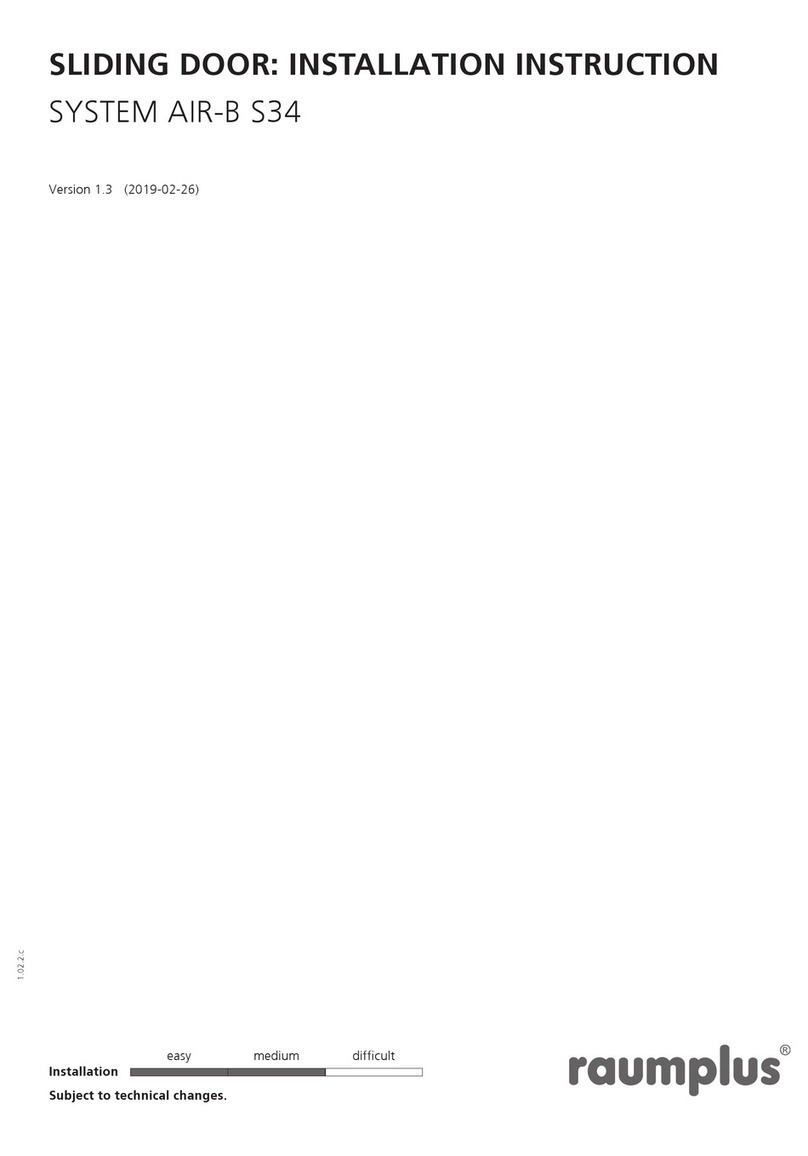
raumplus
raumplus AIR-B S34 Installation instruction
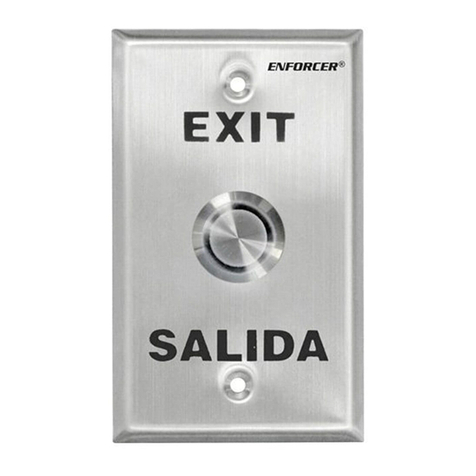
SECO-LARM
SECO-LARM SD-7104SGEX1Q manual
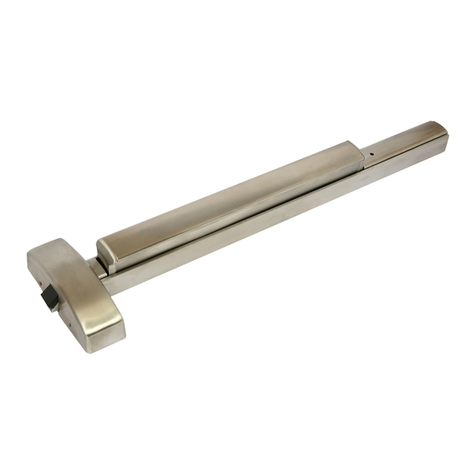
Dorex
Dorex 8500 Series installation instructions

Assa Abloy
Assa Abloy Besam SW200i user manual
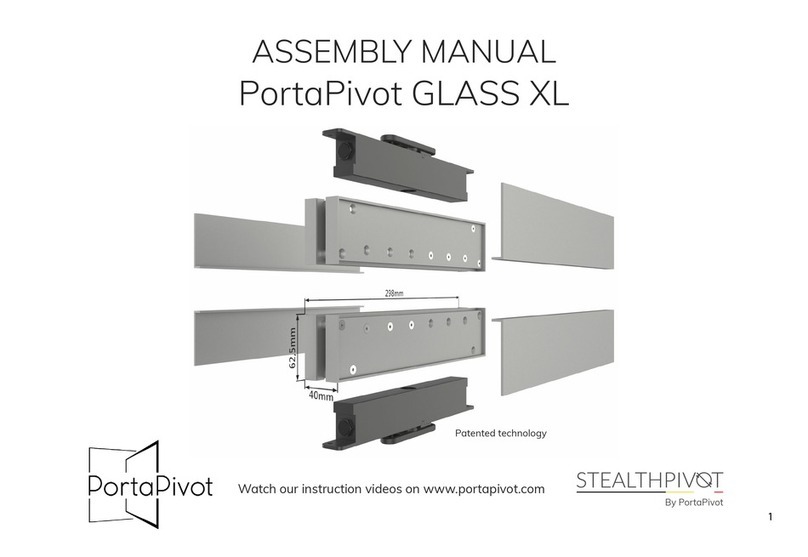
PortaPivot
PortaPivot StealthPivot XL Assembly manual
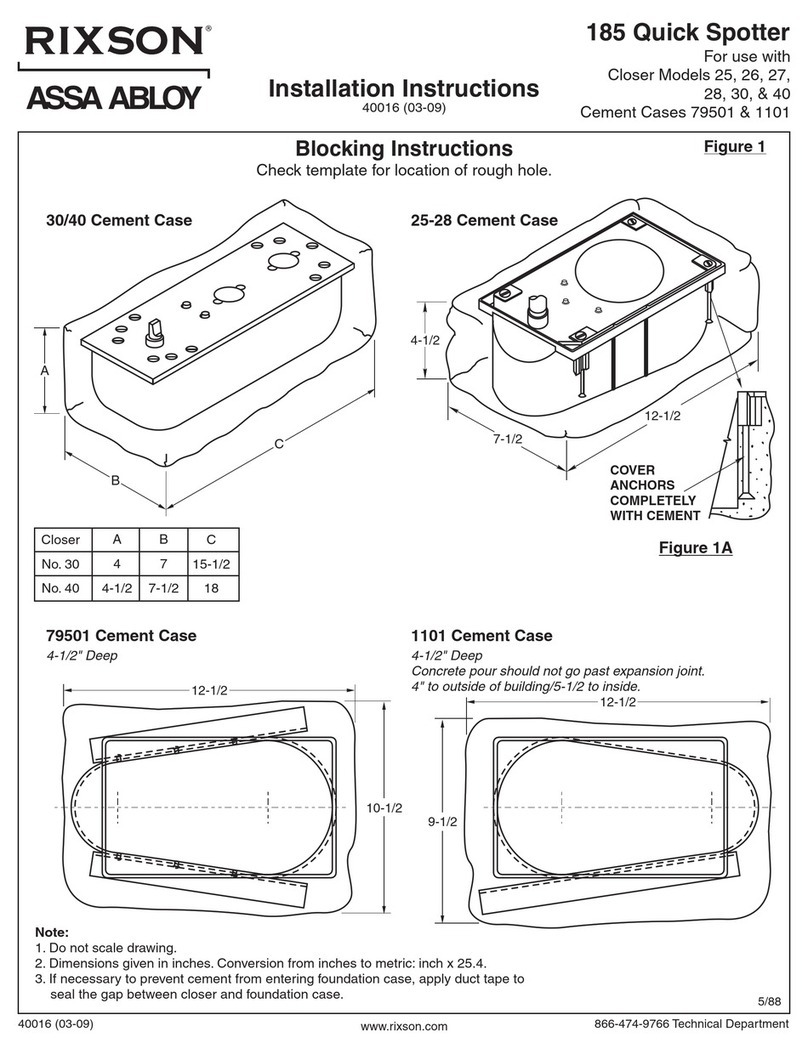
Assa Abloy
Assa Abloy RIXSON 185 Quick Spotter installation instructions
